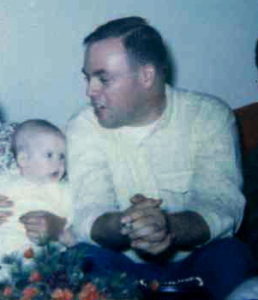It is a story I’ve been hearing every now and then my entire life. On the afternoon before I was born, my mother was chatting with my father while he was shaving at the bathroom sink. Even though I wasn’t due to be born for another two weeks, my mother had noticed a few signs that made her think that the birth of her first child would be happening very soon. I imagine that they might have been talking about how much longer they’d be waiting, or whether or not all of the preparations to their home were going to be done in time. Maybe they were nervous. As their conversation continued, my mother’s water broke suddenly; and my father, in his alarmed reaction to this event, accidentally shaved off one of his late 1960’s-era sideburns.
Such is the stuff of family lore. This is a story that gets retold at intervals with as much loving predictability as the Four Questions at Passover. Now that my father is deceased, we no longer get to hear his side of the story, but that makes its recitation even more important. Each member of my family has their own experience of this story. To my mother it may capture the worried excitement of becoming a mother for the first time. To my younger brother it might give an inkling of the family dynamics that preceded his birth. To me, it paints a vivid picture of my father as young man staring straight into unfamiliar and awesome responsibility. This empathic connection with my father keeps his memory alive and also helps me to make sense of my own experience of being a man.
Every family has its stories, told over and over again, that it comes back to at times of joy and pain. These stories become repositories of meaning. Not only do they chronicle important events, but they also create a space in which to engage with the meaning of these events: context, subtext, emotion, and identity among an infinite number of other shades of meaning. The experience of engaging with these stories is different each time we remember them, just as no two moments in life are precisely the same.Families have stories, and so do civilizations. For the Jewish civilization, text has become the repository of millennia of stories that are the foundation of our faith, laws, and traditions. Torah, Talmud, Midrash, Kabbalah, commentaries and siddurim; Jewish life and culture originate in these texts. Or, from a liberal/Reconstructionist perspective, these texts emerged from the experience of the Jewish people. Regardless of one’s theological orientation, Jewish life and text are intricately intertwined.
By definition, text is static. It remains constant while our circumstances and needs are changing continuously. Those who are skeptical of the relevance of an ancient religion to today’s world point to this dynamic as proof that text has little to offer us other than perhaps a historical record.
Yet just as we know from our family stories, while the text is literally words on a page, the meaning we make of it is up to each of us. Barry W. Holtz, a scholar and a dean at the Jewish Theological Seminary and editor of the now-classic Back to the Sources: Reading the Classic Jewish Texts, described reading text as “a passionate and active grappling with God’s living word (p.17).” That description defies the reality that text is fixed on the page and in time.
The space that exists in between the text and us is a place to encounter the unexpected, the sacred, the true. We can use our intellect, our hearts and our soul to draw in meaning from the words that have been reverently collected, studied and commented upon for centuries. Our age tends to value innovation, and it’s almost paradoxical to believe that an unchanging repository of ideas, laws, and commandments can stimulate new perspectives. Yet somehow it happens constantly.
Stories and text serve us by holding meaning that is contained in words and metaphor. They are always available to us. Family stories come up spontaneously and remind us of where we’ve come from and who we are. Sacred text reminds us of our place in history and can guide us to where we will go next. They are our companions every step of the way.
(Images: Chris & Dad, Bargeron Family Collection; Torah, Ben Leto)






This was a great read! I don’t agree with many things written in ancient texts like the Torah, don’t see the relevance of parts, and don’t agree with some of the interpretations of it drawn by some (usually more religious) people, yet I make my own interpretations based jointly on tradition and my modern way of life and thinking. It’s a balance that works for me and seems to work for you too. Also, stories, of all kinds, help shape and define our own unique lives. We tell stories about our life, or our friends’ lives, or fictional lives, to help others better empathize with us and our experiences. I appreciate the impassioned defense of stories, no matter how ancient they may be.
Thanks for your comment, Bradley. To me, one way of looking at Torah is as if they are old Jewish family stories. They may or may not be literally true, but they capture something meaningful. And our reading of them changes over time.